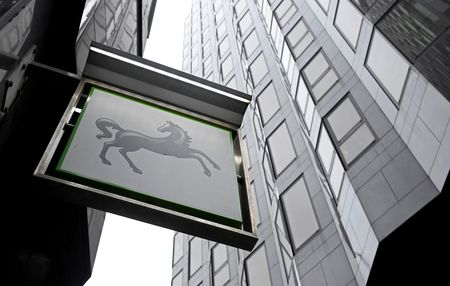By Iain Withers and Lawrence White
LONDON (Reuters) – Britain’s Lloyds Banking Group signalled that falling house prices, competition on savings and rising costs may crimp future returns after reporting flat profit growth for 2022.
Lloyds, Britain’s biggest mortgage lender, said home loan volumes across the sector had plunged to between 1.1-1.2 billion pounds a day, down from 1.5 billion pounds normally, adding that house prices are likely to drop 7% this year.
While British inflation is trending downwards, steep rises in energy, food and mortgage bills are still pinching household budgets and have raised the risk of loan defaults.
Lloyds set aside 1.5 billion pounds in 2022 to cover potential loan distress, a year after releasing 1.4 billion pounds of provisions as the economy rebounded from COVID-19.
“Higher interest rates may have boosted income over the past year, but the uncertain economic outlook they are contributing to is also forcing banks to put aside more provisions,” City Index Market Analyst Joshua Warner said.
Lloyds’ shares dropped 1.9%, amid a broad-based sell-off which saw the benchmark FTSE index slip 0.9%.
The bank reported pre-tax profit of 6.9 billion pounds ($8.4 billion) for 2022, unchanged on the previous year and in line with analyst forecasts it had compiled.
It plans to pay a 1.6 pence per share final dividend and a share buyback of up to 2 billion pounds, taking total shareholder returns for 2022 up to 3.6 billion pounds.
Expenses also rose 6% to 8.8 billion, partly due to rising wage bills as Lloyds boosted its staff bonus pool by 12% to 446 million pounds.
While mortgage volumes across the sector were down on normal times, Lloyds Chief Executive Charlie Nunn said, they had recovered from levels in the weeks immediately after a disastrous government ‘mini-budget’ last September when they fell to about 600 million pounds a day.
The ensuing market chaos led to a mortgage rate spike. While rates had since fallen, many people were still paying higher rates, of around 4%-4.5%, than they were used to, he said.
“We do expect a slower year for mortgages in 2023, so that’s what we’ve built into our plans,” Nunn said.
ELECTRIC AVENUE?
Lloyds – which also owns the Halifax, Bank of Scotland and Scottish Widows brands – is the last of Britain’s ‘Big Four’ high street banks to report full-year earnings, after HSBC, NatWest and Barclays.
Rivals have reported robust profits but struggled to convince investors the boost from higher central bank rates – enabling them to cash in on the widening gap between what they charge on lending and pay out on savings – will be long-lasting.
Lloyds reported a 14% rise in revenues to 18 billion pounds and said it was now targeting a return on tangible equity in excess of 15% by 2026, having previously targeted more than 12%.
But it suggested its net interest margin – a key underlying measure of profitability – may fall this year from its level at the end of 2022 of 3.22%.
Lloyds’ closest domestic rival NatWest unnerved investors last week by suggesting both Bank of England rates and interest margins may already have peaked, dimming the outlook.
Barclays’ shares also slid on its own disappointing outlook and a tough year for its investment bank, while HSBC overcame some investor scepticism with a pledge for bumper payouts.
Lloyds also said it had bought Tusker, a vehicle leasing company that provides electric vehicles via salary sacrifice schemes, for 300 million pounds.
($1 = 0.8256 pounds)
(Reporting by Iain Withers and Lawrence White, Editing by Sinead Cruise and Alexander Smith)

